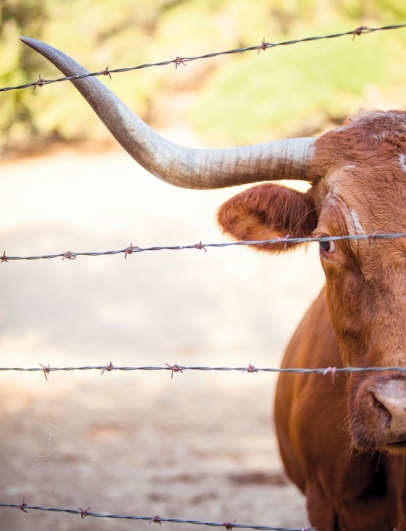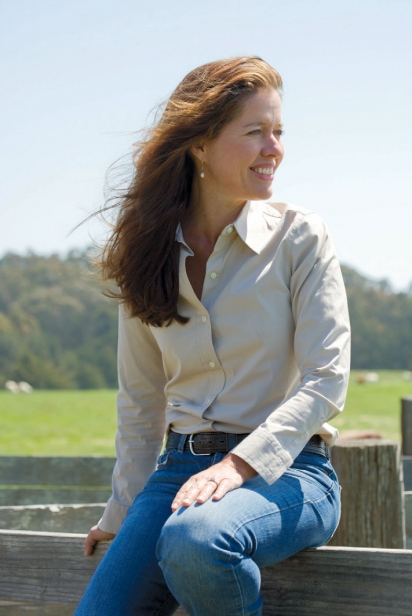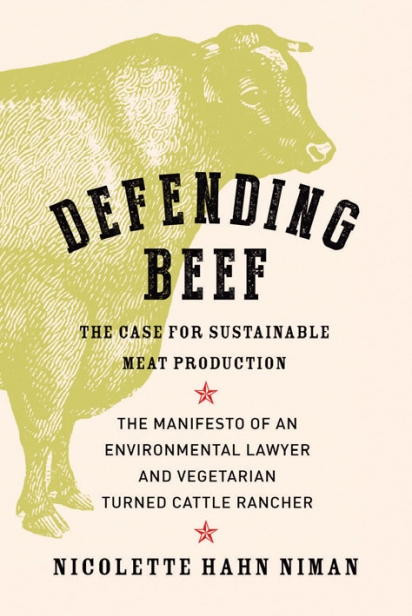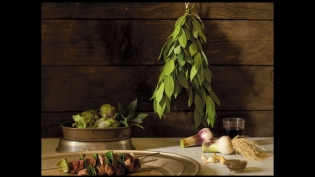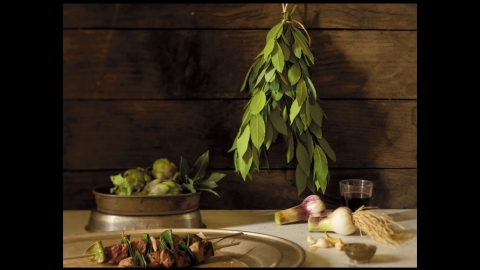All Food is Grass: An Excerpt from Defending Beef
Modern urban dwellers tend to look at grass and see only monotonous, ubiquitous, inedible green ground cover. Environmentally minded landscapers loathe it and have taught us skepticism of expansive, watered, suburban lawns. These days we don’t regard grass as part of our food system, let alone its foundation. Grass’s connection to what we eat seems remote, if we think of it at all.
Grasses cover around 40% of the earth’s land surface, about 70% of the world’s agricultural area, and are the fourth-largest plant family in the world, containing more than 11,000 species worldwide.
Grass is, in fact, the base layer of the global food system. It continually converts massive quantities of solar energy into food for grazing animals. Grasses and herbivores, working together, are the indispensable intermediaries between humans and the energy of the sun.
Their invaluable cohorts, of course, are water and soil. Together, soil and water make grass’s growth possible, while in return grass performs essential services for them. On average, 90% of grass’s bulk is actually below ground, in the form of long, filamentous roots—a tangled network that stops soil erosion. “Grass prevents erosion by binding to the soil,” explains the geology textbook People and the Earth. “Replacement of grasslands with cropland in the American Midwest, its ‘breadbasket,’ has caused nearly one-third of the topsoil to be stripped by erosion in the past 100 years.” Roots of grass tenaciously cling to soils, preventing them from being washed or blown away. Through complex biological processes, grass assists in forming new soils. By creating a massive web of tiny underground channels, and by enabling soil aggregation, grass also renders the earth a far more effective keeper of water.
While even a casual observer can see that grasses feed wild and domestic herbivores, it may be less obvious that the relationship is two-way: Herbivores are nourished by grass, and in turn their grazing and trampling maintains grasslands. Research already presented makes clear that pruning by creatures’ mouths supports vegetative growth. Grazing and trampling also keep down the emergence of woody plants that transform grasslands into environments less hospitable to grass. When grazing animals are extirpated or otherwise disappear from a terrain, the ecosystem, including all life depending on it, is radically altered. Just as mowing helps keep a lawn grassy, lush and full, so grazing triggers plant growth by pruning off old and dead parts and by exposing plants’ growth points to more sunlight.
Beyond the lawn mower effect, grazing animals assist soils and grasses in other ways. Their hooves push seeds into the ground, preventing them from getting blown or washed away, or gobbled up by hungry birds. Cycles of decay, too, benefit from hooves pressing plant parts into soils. Down in the dirt, vegetation becomes enveloped by the decomposing microbes that power carbon and nutrient cycling. The presence of cattle also ensures that moist, nutrient-rich organic matter, long regarded by farmers as agricultural gold—and known to non-farmers as cow patties—is continually added to the soil.
Remember that topsoil harbors billions of microorganisms that help plants get nutrients from organic matter and mineral soil. Soil organisms “supply plants with nutrients by accelerating rock weathering and the decomposition of organic matter.”
Grazing of grasses thus bolsters continuous regeneration of soils and supports grass’s diverse functions, from the microscopic to the ecosystem scale. Dense mats of sod shield soils from being blown away by wind and being washed away by water. Tangled grass root masses hold soils in place, and improve their ability to hold moisture.
Even as part of a crop rotation, grasses, especially when grazed, provide a wealth of benefits. By delivering organic matter and carbon, as previously described, they feed the billions of tiny organisms teeming below the earth’s surface. These microorganisms make nutrients bio-available, thus enhancing the earth’s fertility. Grazing, by stimulating plant growth, and by cycling plant matter through the ruminant’s gut, assists such carbon-nutrient exchanges. Healthy populations of soil microorganisms also provide protection from diseases, pests, and harmful fungi to crops grown in the same soils. Before there were chemical fertilizers, pesticides, and fungicides, there was grass. As I gaze out at the open meadows of our California ranch, I sometimes picture the mind-bending menagerie that covered these lands in prehistoric days. These early animals included the western camel, with limbs 25% larger than modern dromedaries; the large-headed llama; elk, deer, and antelope; two varieties of bison (including the giant bison, the largest one that ever lived); the shrub ox and woodland musk ox; the mountain goat; the bighorn sheep; two types of horses; and two varieties of mammoths. Mammoths abetted forest clearing both by felling trees on which they were dining and by effectively crushing aspiring saplings with their weighty footsteps. Predators feasting on such prehistoric grazing herds included a lion larger than those of today’s Serengeti; a cheetah; a jaguar; a sabrecat (the size of a female African lion); a puma; wolves; and three types of bears.
In California, grassland experts believe that as recently as 6,000 years ago, 19 species of large browsing and grazing animals still populated the open lands. Herbivores ate down vegetation while they, along with their predators, trampled the earth with their paws and hooves. Fires, both natural and human-generated, and the presence of these animals, created and maintained California’s grasslands.
Cattle, of course, are domesticated animals. They belong to the zoological order Artiodactyla (Greek for “even-toed”), suborder Ruminata (cud-chewing animals that are strictly herbivorous). Most modern cattle are believed to be descendants of a much larger, now extinct wild beast called the aurochs.
Cattle first arrived in the Americas in 1493, with Columbus’s second voyage, which brought Spanish breeds, mostly as draft animals. Not until 1591 did the original seed stock for Latin America’s cattle herds arrive, when a Spanish merchant named Gregorio de Villalobos shipped a small group of Andalusian breed cattle to the New World. In the early 1600s, European settlers of North America began landing with early British and Continental breeds, primarily for labor and milk.
As settlers pushed south then pioneers headed west, cattle were part of the migration, proliferating particularly in areas with abundant native grasslands. Many of the earliest cattle ranches were in the South, especially Georgia and the Carolinas. “The long grazing season, mild winters, sparsely wooded uplands were especially favorable for beef production,” notes a cattle history. “It was said that a steer could be raised as cheaply as a hen.”
By the mid-1800s, many cattle ranches were being established on the grasslands of the West. But the bulk of the nation’s cattle raising was taking place in the heart of the country. Europeans spreading across North America encountered grass prairies that had produced the most fertile and abundant topsoil on the planet. Settlers tore open these prairies with their plows to plant row crops. Cutting up the natural sod was tantamount to exploding a vault with our nation’s most precious jewels.
Poor farming practices eroded American topsoil at an alarming rate. Farmers first plowing up Midwestern prairies had been greeted by chest-high grasses and topsoils six feet deep. In 1934, precipitated by years of serious drought and crop failure, a 100-million-acre dead zone on those lands caused epic dust storms as far away as New York City. The center of the country became known as the Dust Bowl. Under Franklin Delano Roosevelt’s leadership, the U.S. government created the Soil Conservation Service in 1935 in the hope of reversing the perilous trend.
Mercifully, by the mid-20th century, Soil Conservation research was revealing solutions to the problem of agriculture. Most important, it showed that regularly rotating croplands into pastures—especially of mixed grasses and clover—reverses much of the damage done by row crop cultivation. Thus, it demonstrated that such meadows not only fed grazing animals, but were also fundamental to creating a permanent farming system that could produce food sustainably over the generations.
Turning away from grass-centered farming has not only robbed billions of animals of decent lives, but also had severe ecological consequences. Soils and waters have lost their stalwart guardian as millions of acres of grasslands have been plowed, and grass buffers and grass crop rotations all but abandoned. Today, agriculture is the nation’s leading source of water pollution and is a significant air polluter, as well, on top of its contributions to global warming.
Especially alarming is the prospect that current agricultural practices, by failing to safeguard our soils, jeopardize our future capacity to feed ourselves. Food production depends on soils created by geological actions over millions of years. But American soils are being blown and washed away at rates far faster than the earth can regenerate them. Scientists estimate that farming that leaves bare soils exposed for much of the year has caused the United States to lose 30% of its topsoil over the past two centuries. Other than overpopulation, soil erosion is the single greatest threat to humans’ continued ability to produce sufficient food, according to Cornell University’s David Pimentel.
Alarmingly, Americans are still shredding and stripping native grasslands with the plow. Research published in February 2013 in the Proceedings of the National Academy of Sciences by scientists at South Dakota State University found that between 2006 and 2011, farmers in the Dakotas, Minnesota, Nebraska, and Iowa had plowed up 1.3 million acres of native grassland in order to plant corn and soybeans.
Even putting aside water use and soil erosion, current agricultural methods will no longer be viable in the not-too-distant future. The manufacture of fertilizers, pesticides, and herbicides is fossil-fuel-intensive. Confinement animal operations and feedlots are particularly dependent on cheap, abundant fossil fuels because of their mechanization, and their use of row crop feeds, which are energy-intensive to produce and often transported great distances. Fossil fuels are a finite, diminishing resource that many experts believe are already more than half expended. More urgently, as PhD soil scientist and dairy farmer Francis Thicke argues, the extreme oil price spikes predicted for the coming decade will render fossil-fuel-based agriculture impractical long before the world’s oil runs dry.
Food production that can truly be sustained over time will take new policies and approaches. Tomorrow’s farming cannot look like the agriculture of today. And transformation is urgent. Rather than haphazardly reacting to future environmental and oil crises, the United
States should be engaging now in an orderly and deliberate transition away from fossil fuels and toward grass.
To begin the shift, Congress should act forthwith to reinvigorate the 1985 soil conservation standards. It must also forge future farm bills that tie incentives to safeguarding natural resources.
Agricultural subsidies and incentives should, across the board, foster the use of grass. Farmers should be rewarded for converting croplands to grasslands, rather than the other way around, and for using grass cover crops instead of chemicals, and establishing and maintaining grass buffers. All farm animals, but especially cattle and other grazing animals, should be moved out of buildings and feedlots and reared on grass instead, on meadows, rangelands, or as part of mixed-crop rotations.
Fertility and pest control from grass rather than chemicals comes from biological processes. Using manmade fertilizers, insecticides, and fungicides is food production based on externalized costs (also known as throwing the garbage over the fence). We need, instead, food production with a full accounting. We need a food system that truly regenerates and preserves resources. With grass we can regenerate fertility and keep away pests without chemicals, breaking away from polluting, soil-eroding systems. With animals on grass, we can reestablish ecosystems closer to the way they evolved and were intended to function. At the same time, we can rebuild soils and sequester carbon. In short, we can raise animals and grow food in ways that sustain natural resources for future generations.
Making grass, rather than chemicals and mechanization, the foundation of our food system is a massive but necessary shift. Farming based on grass would likely involve the United States raising fewer farm animals and entail additional labor (for more animal husbandry and for the planting of cover crops), which means higher production costs. In the short term, it would also mean lost farm revenue in refraining from cultivating every available acre. (It is unhelpful that large swaths of cropland are now rented rather than owned, which disconnects farmers’ economic interests from the benefits of longterm conservation.)
The move beyond fossil-fuel-based farming is at once unavoidable and essential. And with such a transition, cattle, as maintainers of grasslands and converters of grass to meat and milk, will play a central role. Perhaps we will yet fully realize the stalled dream of an American farming founded on grass.


